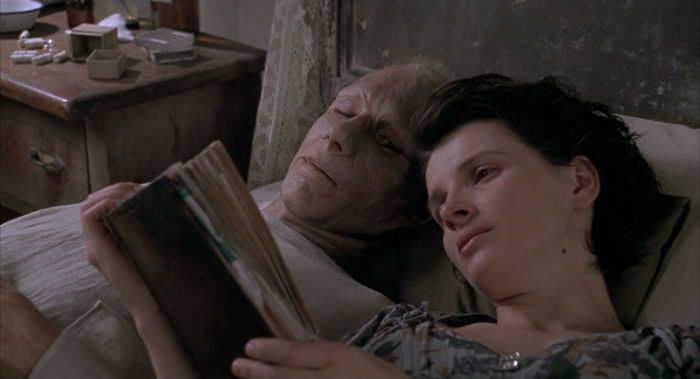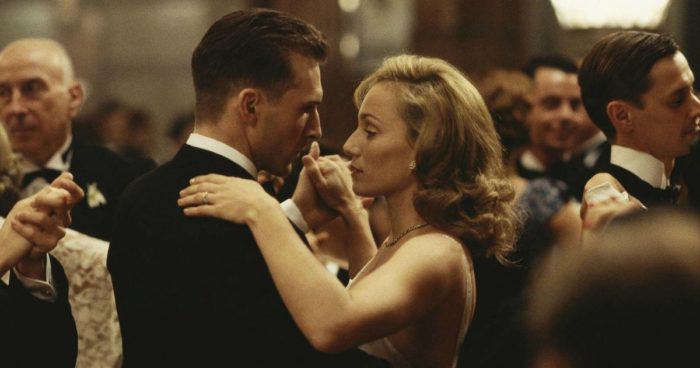
The 69th Academy Awards (1997)
Nominations: 12
Wins: 9
Probably not the most appropriate review to accompany today’s news, considering this is a very white person movie. But hey, my Guess Who’s Coming To Dinner review is still sitting there for the reading if you want.
Anyways… going into The English Patient, I wasn’t really sure what to expect, since the two things I equate this movie with don’t actually have much to do with the content of the film itself. One big thing about this movie for me is that it took home a bunch of Oscars at the first Academy Awards ceremony I can remember watching live on TV. Granted, it’s not like its ability to bring home the gold inspired me to seek it out (until now), since I wasn’t exactly interested in a sweeping romantic epic at the age of eight. As you could probably guess, the other thing I equate with this movie is the episode of Seinfeld called “The English Patient”, where Elaine Benes is driven insane by being seemingly the only person in her life that doesn’t love the film in question.
After watching The English Patient, it’s not hard for me to see why a Seinfeld writer felt compelled to write an entire plotline inspired by them not getting all the praise for this movie. While there is plenty to enjoy about the film, it doesn’t scream crossover success the way a lot of the other period-piece films that won Best Picture in the ’90s did. It’s a very novelesque, somewhat dreamy movie that doesn’t have a ton of huge setpieces or really any big hook other than the tragic nature of its love story and seeing Ralph Feinnes in a ton of prosthetic make-up. However, I think it did lay the groundwork for what next year’s big Oscar winner, Titanic, was able to tap into, as it’s also a romantic historical epic that was probably a lot more appealing to women than it was to men.
The English Patient begins in the Sahara desert, showing a plane crash in which the pilot (played by Ralph Fiennes) seems to have been badly burned. We then turn to the Italian countryside, where it’s towards the end of World War II and a French-Canadian medic named Hanna (Juliet Binoche) finds her and her colleagues trying to avoid landmines that have been planted by the Germans. She’s then assigned to take care of an English Patient, László de Almásy, the man who went down in the plane crash and who now looks fairly Voldemort-like with his whole body covered in burns. As Hanna starts getting to know Almásy, he begins to tell her the story of how he ended up in the desert, while the film constantly flashes back and forth in time.
We learn that Almásy was involved in an archeological expedition in the Saharan region of Egypt, where he was serving as a cartographer on the trek. However, things become a little more complicated when the men in the expedition are joined by a British couple, Geoffrey and Katharine Clifton (Colin Firth and Kristin Scott Thomas), while Almásy becomes infatuated with Katharine. While Geoffrey is away, Almásy and Katharine begin an intense affair, which leads to Geoffrey finding out and attempting to take out Almásy with his plane (with Katharine in tow), but ends up killing just himself in the process. Then Almásy must travel across the desert in order to find help, but runs into some British soldiers who basically refuse to help him. Also, while current-day Almásy is telling his story, Hanna falls in love with a nice Sikh explosive expert and Willem Dafoe is there as an intelligence operative who crossed paths with Almásy during the war.
I feel like I’m still leaving some things out about the plot of this movie, which is a bit odd since The English Patient never felt like that complicated of a story to me, or at least not one complicated enough to entirely earn its 162-minute run time. Though the way the film flips back in forth in time does add a nice dynamic, while the things happening in the present feel developed enough to not just make these scenes feel like merely a framing device. I guess in the end, there just weren’t enough unique things about the love story between Almásy and Katharine to always keep me engaged. That said, the setting of the desert is certainly an evocative one, and the film’s cinematography makes great use of its gorgeous landscapes.
While I’m not sure this is the most compelling love story ever put to film, I think it also benefits greatly from featuring four top-billed cast members who are always interesting to watch on screen. Fiennes, Binoche, Scott Thomas, and Dafoe are all actors I have varying degrees of familiarity with, but seem to always be stealing a scene in whatever movie they pop up in. Here, they’re all kind of playing the types of characters they’re good at (Dafoe’s wonderfully-named Carravagio turns out to be a heroin addict with no thumbs), but this is early enough in all their careers that they’re able to find some life in these characters that could’ve easily felt embalmed in wax.
As I mentioned earlier, The English Patient probably would’ve been a little more engrossing for me if it shaved off a good 20 minutes or so, as my interest did start to drift at a certain point. It’s hard to imagine this was the film’s intention, but it does have a very dreamy quality due to its constant fades between the past and present, courtesy of one of the few film editors I know by name, Walter Murch. It’s unsurprising that Murch, along with the rest of the production side of the film won a bunch of Oscars for The English Patient (including Cinematography, Art Direction, and Costume Design), as it is a beautiful film to look at. However, it’s also unsurprising that this movie is a bit forgotten, as it doesn’t bring to life this kind of historical romance in quite as universal a way as that big boat looming on Oscar’s horizon.


